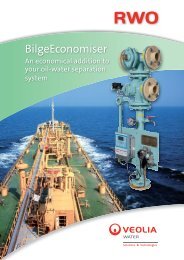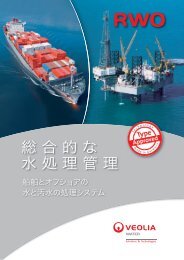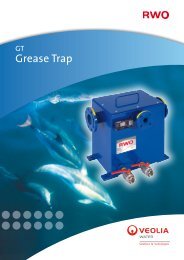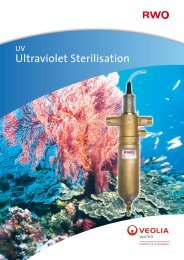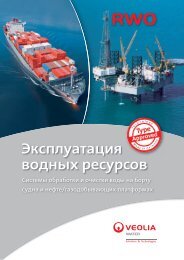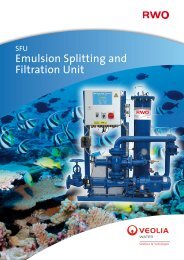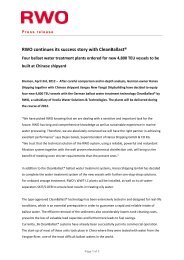the IHS Ballast Water Guide - RWO Marine Water Technology
the IHS Ballast Water Guide - RWO Marine Water Technology
the IHS Ballast Water Guide - RWO Marine Water Technology
Create successful ePaper yourself
Turn your PDF publications into a flip-book with our unique Google optimized e-Paper software.
<strong>IHS</strong> Fairplay Solutions <strong>Guide</strong> to <strong>Ballast</strong> <strong>Water</strong> Treatment Systems Sponsored by<br />
micro-organisms. In addition, <strong>the</strong> electrolysis<br />
cell’s special coating ensures sufficient<br />
chlorine concentration.<br />
During deballasting, residual chlorine<br />
is neutralised by <strong>the</strong> addition of sodium<br />
bisulphite solution. Great emphasis has been<br />
placed on monitoring and control to ensure<br />
proper operation and effective neutralisation<br />
of treated ballast water prior to discharge to<br />
sea. The control unit logs <strong>the</strong> status of <strong>the</strong><br />
system, operation, electrolytic cell, selfcleaning<br />
filter and cyclonic separator. ar arator or or. or or.<br />
<strong>Ballast</strong>Master<br />
GEA Westfalia<br />
2 7<br />
Its maker maintains that <strong>the</strong> <strong>Ballast</strong>Master<br />
system requires low amounts of energy and<br />
has a neutral effect on <strong>the</strong> environment.<br />
<strong>Ballast</strong>Master operates in three stages.<br />
First, during <strong>the</strong> filtration phase, ballast water<br />
is taken on board and passed through a backflush<br />
cartridge filter that removes particles<br />
larger than 40µm at up to 1,000m 3 /h. In <strong>the</strong><br />
second stage, disinfection, an active substance<br />
is added directly into <strong>the</strong> pipe leading to <strong>the</strong><br />
ballast tank.<br />
An oxidate created on board using<br />
electrolysis is used as a disinfectant. This<br />
is produced from a simple sodium chloride<br />
solution, consisting of common salt and<br />
freshwater, and is added to <strong>the</strong> ballast water<br />
that has been taken on board.<br />
The oxidate breaks down into its original<br />
ingredients when exposed to ultraviolet<br />
radiation, which makes <strong>the</strong> substance<br />
inactive. Any possible after-effect of <strong>the</strong><br />
processing is counteracted in <strong>the</strong> third<br />
stage, neutralisation. As <strong>the</strong> ballast water is<br />
discharged, a sulphur-based neutralisation<br />
agent is added, if required, to reduce <strong>the</strong> total<br />
residual oxidants (TRO) content to below<br />
<strong>the</strong> level of 0.2ppm specified by <strong>the</strong> IMO.<br />
An important point is that <strong>the</strong> system<br />
works with low energy and operating costs.<br />
The installation of a plant with a capacity of<br />
500m3 /h is said to require an electrical current<br />
of less than 8kW, most of which appears to be<br />
required for <strong>the</strong> electrolysis of <strong>the</strong> he dis disinfectant. is isinfe fectan an ant.<br />
SEDNA<br />
Hamann<br />
2 1<br />
The SEDNA system developed in Germany<br />
by Hamann was one of <strong>the</strong> first systems to be<br />
given full approval in 2008.<br />
Physical separation is in two stages: a<br />
hydrocyclone followed by a compact, selfcleaning<br />
filter with 50µm meshes. The<br />
cleaning of <strong>the</strong> filter is triggered by <strong>the</strong><br />
differential pressure. During backflushing <strong>the</strong><br />
filter elements are cleaned one by one with<br />
seawater without addition of any cleaning<br />
substances. When backflushing <strong>the</strong> ballast<br />
water operation continues at a slightly<br />
reduced flow rate.<br />
The system can be adapted to different<br />
ballast water pump capacities, ranging in size<br />
from 200m 3 /h to 1,000m 3 /h for individual<br />
installations. <strong>Ballast</strong> water pump capacities in<br />
excess of 1,000m 3 /h are said to be possible.<br />
In addition to physical treatment, <strong>the</strong><br />
system makes use of Peraclean Ocean (a<br />
chemical substance developed by Evonik-<br />
Degussa). This substance has created problems<br />
for <strong>the</strong> system because although it performs<br />
as expected under most circumstances,<br />
at extremely low sea temperatures and in<br />
freshwater it does not degrade and so can<br />
remain active in <strong>the</strong> environment.<br />
The fully approved ballast water treatment<br />
system was withdrawn from <strong>the</strong> market<br />
after concerns were expressed that <strong>the</strong> active<br />
substance it uses could remain toxic after<br />
discharge. Under pressure from <strong>the</strong> German<br />
authorities, fur<strong>the</strong>r tests were carried out<br />
18 © <strong>IHS</strong> Global Limited 2012<br />
012_037_CorrectedBW1204.indd 18 01/08/2012 15:31:59



